Interstellar Blu-ray Movie
HomeInterstellar Blu-ray Movie 
Blu-ray + DVD + UV Digital CopyParamount Pictures | 2014 | 169 min | Rated PG-13 | Mar 31, 2015
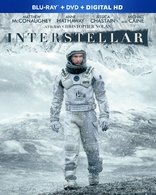
Movie rating
8.4 | / 10 |
Blu-ray rating
| Users | 3.9 | |
| Reviewer | 4.0 | |
| Overall | 4.0 |
Overview
Interstellar (2014)
With our time on Earth coming to an end, a team of explorers undertakes the most important mission in human history: traveling beyond this galaxy to discover whether humanity has a future among the stars.
Starring: Matthew McConaughey, Anne Hathaway, Jessica Chastain, Ellen Burstyn, John LithgowDirector: Christopher Nolan
| Adventure | 100% |
| Sci-Fi | 92% |
| Melodrama | 20% |
| Drama | 17% |
Specifications
Video
Video codec: MPEG-4 AVC
Video resolution: 1080p
Aspect ratio: 2.39:1, 1.78:1
Original aspect ratio: 2.39:1
Audio
English: DTS-HD Master Audio 5.1 (48kHz, 24-bit)
Spanish: Dolby Digital 5.1 (640 kbps)
French: Dolby Digital 5.1 (640 kbps)
Subtitles
English SDH, French, Italian, Portuguese, Spanish, Dutch
Discs
50GB Blu-ray Disc
Three-disc set (2 BDs, 1 DVD)
UV digital copy
DVD copy
Packaging
Slipcover in original pressing
Playback
Region A (locked)
Review
Rating summary
| Movie | 4.5 | |
| Video | 4.5 | |
| Audio | 4.5 | |
| Extras | 3.5 | |
| Overall | 4.0 |
Interstellar Blu-ray Movie Review
A journey beyond time and space.
Reviewed by Martin Liebman March 17, 2015Interstellar's ambitions are both clear and vague, complex and simple, powerful and poignant, purposeful and hopeful. The film evokes the style and structure of the best of Star Trek and Shyamalan with a substance comparable to that of 2001 and that drives as deep, if not sometimes more deeply, than Stanley Kubrick's legendary film. Director Christopher Nolan's (the Dark Knight trilogy) Interstellar may not be quite so ahead of its time as Kubrick's masterwork was back in 1968 in terms of its technical merits but the film does strive to match, and sometimes overtakes, it in terms of its core narrative in which the fantastical gives way to the fantastically complex as it explores -- throughout space and both in a moment and over a number of years -- core ideas surrounding the true strength and bond of the human condition, a bond which the film says cannot be severed by either time or space, a bond which can overcome even the most impossibly complex scenario. Sometimes convoluted, sometimes impractical, sometimes too fast, occasionally too slow, consistently epic, ofttimes surreal, unfailingly mesmerizing, and always focused on a greater goal and always moving towards a simple yet evolved endgame dynamic, Interstellar dazzles on multiple levels and leaves the audience in awe of its boldness, complexity, intelligence, and even entertainment value but at the same time questioning if it couldn't have been a little tighter, meant a little more, dug a little deeper, found a slightly more consistent rhythm, discovered an even better way to tell an important and meaningful yet complicated tale that echoes with a profound sense of purpose and the need to explore it further on more intimately personal emotional and intellectual levels.
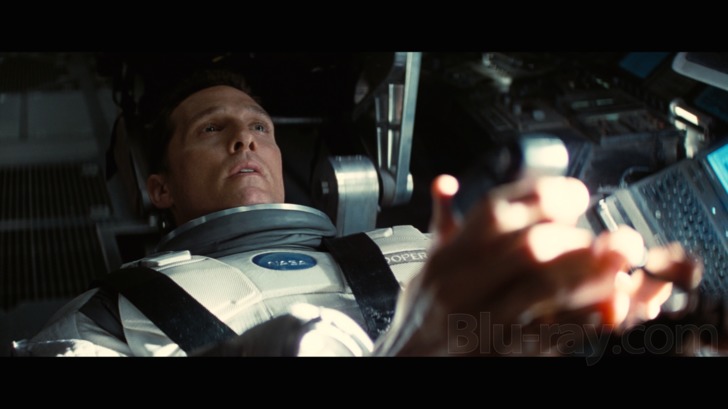
To the unknown...and the known.
Very mild spoilers follow, the kind that only hint at small bits and pieces that make up the greater 'Interstellar' experience. This is a movie best watched as blindly as possible the first time around. Multiple viewings, armed with one's own insight into what the movie has to say, tries to say, succeeds at saying, and fails at saying will aid necessary subsequent interpretations. Yet these mild spoilers -- even as they're merely allusions -- may influence one's perception of the movie as it unfolds. Proceed with caution, or skip to the technical Blu-ray review in the video and audio sections and come back later for the rest.
A near future world is covered in dust. Wheat and okra crops have been wiped out, leaving only corn to grow with any sort of healthy consistency. Life goes on, but not life exactly as it once was. There's no more military, no more wide acceptance into college, no more spending on expensive programs. Life is about survival, though certainly simple pleasures like baseball remain. It's a challenging life, not an impossible one. One day, a dust storm rolls through town. Murph (Mackenzie Foy) and her father Cooper (Matthew McConaughey) find a pattern in the dust as it lays on her bedroom floor, much like the pattern that she frequently finds on her bookshelf, which she calls the work of a "ghost." Cooper and Murph decipher the code and realize it's pointing them to a spot on the map. They soon discover that the point leads them to the last remnants of NASA, working in a secretive underground operation. NASA knows the planet is doomed and is preparing a space flight to follow up on previous leads about potential relocation sites in another galaxy that has been opened to them by way of a mysterious wormhole that has recently appeared within the solar system. Cooper is asked to pilot the mission; he's a former test pilot and the best chance the flight has of succeeding. He leaves for the stars and leaves behind his son Tom (Timothée Chalamet), his father-in-law Donald (John Lithgow), and a distraught Murph, who strongly believes the ghost is urging him to stay home. His crew consists of Brand (Anne Hathaway), Romilly (David Gyasi), Doyle, (Wes Bentley), and two robots, TARS (voiced by Bill Irwin) and CASE (voiced by Josh Stewart).
Interstellar manages to pack in a dense and fully realized yet fundamentally familiar future world in its opening minutes, sharing a good deal of information in relatively short order but, in these early moments, making every line and shot matter as it almost effortlessly builds towards the more fascinating realms of its core story. As the movie inches ever further away from its "Disaster movie" underpinnings and closer to its true narrative purposes that eschew typical genre convention, it opens up to explore a much more satisfying field of view that's not concerned with imminent destruction or the physical salvation of lives but instead a broader examination of the connection shared by humanity. There, the hero, or heroes, are defined not so much by their outward actions but by their inward essences and how they use that internal guide to not only reach point B from point A but also to bend their will and broaden their understanding of themselves, and everything around them, to accomplish their goals of togetherness, understanding, and yes, even salvation, though not necessarily in the traditional usage of the terms. In many ways, the film uses the idea of the wormhole and the simple demonstration of unrelated but overlapping points on a folded plane not so much to depict part of the science behind the film but rather to demonstrate the driving force that is its exploration of mankind through the prism of both the shared and disparate experiences of place and time between Cooper and his daughter Murphy. It's a complex narrative to be sure and one that's difficult to explore without spoiling the movie in its total, but needless to say there's a wonderful bit of storytelling and multifaceted detail that the audience will find both compelling and evolving with every watch.
As with the "Disaster movie" underpinnings that carry the early part of the movie, much of its middle stretch -- and a little further back into the first act, and through parts of the third -- operate under the "what's out there?" pretext, that sense of awe and wonder at discovering the unknown. Yet the movie takes even these broader strokes and gradually manipulates them to mean something else, again on a more intimate level or, at least, concerning the collective structure of the human race. For example, salvation through death and destruction is a recurring theme. In one of the most interesting stretches in the film, it juxtaposes -- spoiler alert -- Matt Damon's Mann (and it's no coincidence he's named "Mann") on another world with Jessica Chastain's Murph on Earth. Both, simultaneously, engage in acts of destruction with the goal of their conception of a greater good in mind, though certainly with Mann the story runs a fair bit deeper. Nevertheless, it's a beautiful parallel that contextualizes a dueling philosophy on several levels, about finding a way to see a raw goal succeed but also contrasting a larger dynamic that runs through the film, particularly its "Plan A" and "Plan B" narrative driving force. This segment stretches to both ends of the human condition: the seemingly unending destruction that's marked mankind's history, the thematic idea of Newton's third law about moving forward only by leaving something behind, and the unquenchable thirst to live and move on at any cost, contrasting actions taken on behalf of the greater good and actions taken on behalf of oneself and how they can sometimes work in tandem and sometimes on disparate, incompatible levels.
There's no doubt that the movie can get more than a little convoluted as it approaches, and works through, its third act and its final resolution of a core story that challenges man to understand the greater universe and, in turn, himself, on a plane of existence far beyond one's general perception and grasp of life and what it means to live under the broader, accepted conditions that has defined mankind since (presumably) its beginning. Interstellar is presented in a way through which the process means more than the truth. Whatever science facts it gets right or wrong, no matter how far it stretches believability or the boundaries of known laws on multiple planes, doesn't really matter. What matters is that connection the movie makes, the more emotional and even spiritual themes it explores. It uses all the grandiose pieces that support it to get to the final resolution, the final truth, through a story made of grand visions of space and time but also the inward emotional turmoil, the tangible pain, the lingering doubt, the constant fear, the evolving perception, the need to connect and reconnect that defines characters, relationships, and and mankind itself, not to mention the truth that nothing -- not disaster, not certain death, not the distance of space, not the onward march of time -- can stop that pursuit of that connection and, ultimately, the connection itself.
Interstellar is also a broader technical marvel. Nolan has rightly chosen substance over style, practicality over flash, people over the power of an artificial epic scale. The movie feels large, involved, and detailed without sacrificing a tangible realism. The movie is more than comfortably familiar both on Earth and through the technology used to stretch beyond. Some of it is vague, but it all works together in a beautiful, harmonious relationship with the individuals and the ideas they, and their story, carry on through to the end where it's not rockets and gadgets and gizmos but rather the simplest -- yet also the most complicated -- concept of the human bond that comes to define the movie. Still, Nolan has spent the appropriate resources to make a beautiful, bold, and satisfying frame in which the more intimate journey unfolds. The film's physical scale effortlessly blends into its most intimately emotional bits and character details. The entire thing feels fully organic and effortless, save for Hans Zimmer's score that sometimes feels too drummed up, too invasive, too much and upsets the film's balance of precision and detail with an overpowering march that sometimes subtly sounds like klaxons blaring underneath the action and, elsewhere, like the music is trying to give an unnecessarily hard edge to a delicate moment in the movie and sometimes even devours dialogue and surrounding sonic details. That said, the movie is otherwise a technical masterpiece that's every bit as much fun to look at as the greater movie is to understand.
Ultimately, and despite everything that's clearly good with the movie -- the many physical, emotional, and metaphysical areas it so complexly, and often gracefully, explores -- and some of the things that aren't quite clearly bad but do leave one questioning parts of the movie -- a sometimes wayward score, later scenes that feel a little out of touch, a general sense that there's just more to explore, more to grasp, more it could have done to fully immerse the audience both in its greater universe and its most intimate corners alike -- it doesn't feel fully fair, or even completely right, to pen a review after a single viewing, or two in a single day, as was the case for the purpose of this review. Consider this review, then, an initial gut reaction, which is all one can really -- honestly -- give following a movie of this technical scope and, much more importantly, emotional and metaphysical scale. Even decades removed from release, movies like 2001 continue to thrive under the watchful eye of scrutiny, the hopeful vision of interpretation, the continued dissection, reassembly, and further dissection of its many moving and stationary parts alike. Interstellar seems destined to follow suit, not only because of a shared bond of style and outer space setting but because of the complicated endeavors in which both undertake that extend well beyond the basic confines of question-and-answer and enter, and pursue, an entire realm of thought-provoking possibilities. Also then consider this review a peek inside the door, a brief overview of what's immediately noticeable inside and a quick reaction to what's been seen but that deserves a much deeper, more prolonged examination in the years to follow.
Interstellar Blu-ray Movie, Video Quality 
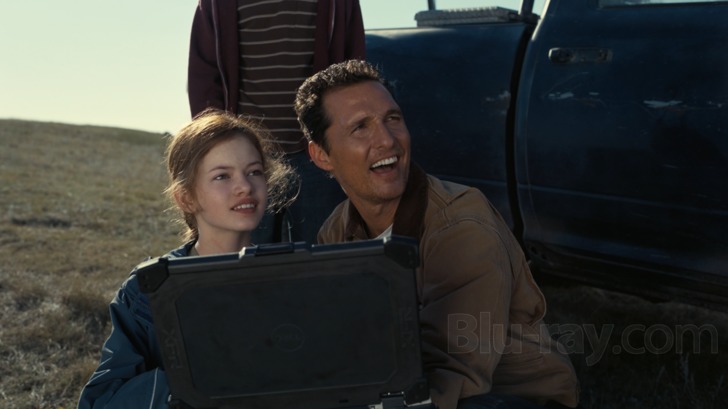
Interstellar's 1080p transfer features a blend traditional scope widescreen at 2.39:1 and an IMAX Blu-ray full-frame 1.78:1. The transitions are seamless, not because the ratios are visually similar -- they're not -- but because they flow with the film and support the narrative structure. Audiences watching the movie and not actively looking for the shifts will likely only ever notice on a subconscious level. That said, the image generally looks terrific, but there are a number of small caveats to get out of the way first. Black levels sometimes appear a little pale, particularly early in the movie, but tighten up nicely and are picture-perfect across star-filled outer space exteriors. Flesh tones often push a bit warm. Smeary edges are uncommon but not often problematic, but there are a couple of facial shots that go inexplicably smeary, a notable example being a scene featuring Cooper and Donald sitting on the porch before Cooper leaves for space. Other minor issues appear, but not to excess, including light banding, faint microblocking, and even a stray hair visible on top of the screen around the 29:25 mark that remains for several seconds. All of that said, the image generally dazzles. Details are frequently precise and a pleasure to behold. The accumulated dirt, faded paint on the truck and house, grimy tiles, alien terrains, the brushed metal robot lines, space suit textures, and human faces are frequently astonishing in terms of the raw visible details. Light grain remains, particularly around the 2.39:1 imagery. Colors are precise throughout as well. Though much of the film favors earthy, dusty textures on Earth and more bleak and monochromatic shades of gray on the alien worlds, there's still a good, even color palette to enjoy, whether that faded blue pickup, lush green rows of corn, red and blue American flag colors, and more. They're healthy and accurate throughout the film. Interstellar's problems may be many, but they don't add up to much in total. Overall, this is a brilliant, exceptionally well done transfer from Paramount.
Interstellar Blu-ray Movie, Audio Quality 
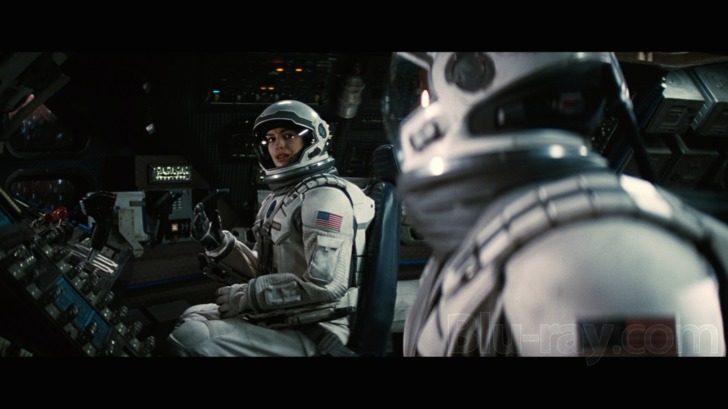
Interstellar arrives on Blu-ray with a strong DTS-HD Master Audio 5.1 lossless soundtrack. While a fuller 7.1 experience would have been preferable, the 5.1 track carries the material just fine and still constructs a rich, detailed, and immersive world. The track finds a perfect balance between every detail, whether light outdoor atmospherics or booming, drifting thunder, spaceship blast-off, or the heaviest dust storms that batter the soundstage with a thick, heavy wall of gushing winds and pelting debris at a believably heavy, aggressive level. Music is likewise capable at any volume, from the faintest little support pieces to the most thunderous details of Hans Zimmer's ofttimes ferocious score that's supported by a deep, fully realized low end and wide surround support. Unfortunately, there are some moments where the music consumes everything else. Whether by design or not, the score swallows up dialogue and surrounding sonic details to the point that it's a strain to hear the words and impossible to hear anything else. The track explores some of the more subtle bits inside the spaceship -- beeps, rattles, and little details alike -- with commendable attention to detail and placement. Dialogue, save for those times when it's devoured by music, is focused, clear, and precise with a consistent center channel flow. On the whole, this is a brilliant, aggressive, and highly enjoyable listen from Paramount.
Interstellar Blu-ray Movie, Special Features and Extras 

Interstellar contains all of its supplements on a dedicated second Blu-ray disc with optional English, French, and Spanish subtitle options.
Inside the Blu-ray case, buyers will find a DVD copy of the
film,
a voucher for a UV/iTunes/Google Play digital copy, and a collectible IMAX film cell.
- The Science of Interstellar (1080p, 50:20): Matthew McConaughey narrates a fascinating look at the film's scientific foundations, the work of consulting Scientist Kip Thorne, basic film themes, the science behind the search for planets capable of hosting life, space-time and the theory of relativity, the science of wormholes and black holes, crafting the film's visuals based on real scientific observation, the birth of the universe, the Dust Bowl and the evolution of dust as a toxin, the likelihood of future dust storms, the prospects of escaping a dying or doomed planet, and the possibilities of colonizing Mars.
- Inside Interstellar: Plotting an Interstellar Journey: (1080p, 7:49): Cast and crew discuss project origins, the film's imagery, ambitions, incorporating IMAX footage, and the human element within the film.
- Inside Interstellar: Life on Cooper's Farm (1080p, 9:43): A closer look at the farm shooting locations outside of Calgary, set construction and design, working with real corn, and more.
- Inside Interstellar: The Dust (1080p, 2:38): Throwing real dust into the frame rather than adding it digitally.
- Inside Interstellar: Tars and Case (1080p, 9:27): a closer look at the film's mechanical characters, including backstory, design, the blend of practical and digital effects in bringing them to life, the differences in the characters, and the human performances behind the characters.
- Inside Interstellar: The Cosmic Sounds of Interstellar (1080p, 1:20): A brief look at the creative process behind the film's music.
- Inside Interstellar: The Space Suits (1080p, 4:31): A look at design, form, and function.
- Inside Interstellar: The Endurance (1080p, 9:24): Designing the vehicle to resemble the International Space Station and again built with authentic function and needs in mind. It also offers a detailed tour of the interior.
- Inside Interstellar: Shooting in Iceland: Miller's Planet/Mann's Planet (1080p, 12:42): A detailed look at the Icelandic locations that stood in for alien landscapes in the film and the challenges and benefits the locations offered.
- Inside Interstellar: The Ranger and the Lander (1080p, 12:20): Further tours of vehicle interiors as well as function, design, and construction details.
- Inside Interstellar: Miniatures in Space (1080p, 5:29): A closer look at the use of models of various sizes and built for various purposes.
- Inside Interstellar: The Simulation of Zero-G (1080p, 5:31): As the title suggests, this piece looks at the processes of simulating the absence of gravity in the film.
- Inside Interstellar: Celestial Landmarks (1080p, 13:22): Another examination of the scientific details and theories utilized throughout the film and that propel the story.
- Inside Interstellar: Across All Dimensions and Time (1080p, 9:02): A look at theorizing, designing, and implementing one of the crucial end-film visuals.
- Inside Interstellar: Final Thoughts (1080p, 6:02): Cast and crew reflect on the film and their hopes for it as an influence and inspiration for future generations.
- Trailers (1080p): Teaser (1:52), Trailer 1 (2:34), Trailer 2 (2:35), and Trailer 3 (2:29).
Interstellar Blu-ray Movie, Overall Score and Recommendation 
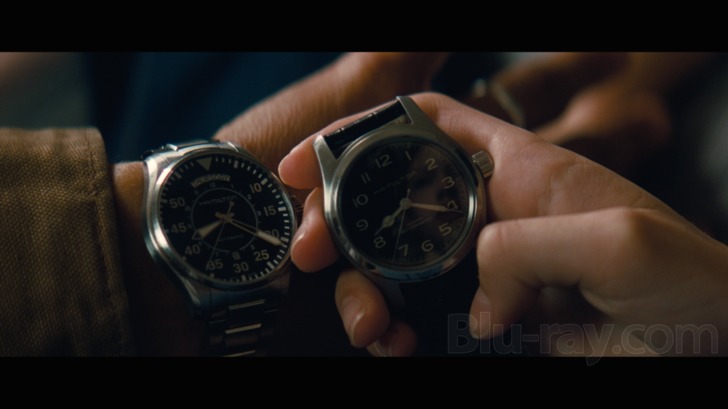
Interstellar may not quite appear to be a total masterwork on the matters of which it explores, at least upon initial viewing, though it's certainly clear after one or two views that the film stands as tall as anything else out there by way of its grace and grandeur on one hand and its lofty ideas on another. Add to that its superficially accessible yet inwardly deep and complex themes not about time and space but the bondings of humanity that exist beyond the physical realm and even the raw lifeblood of family. The film doesn't shy away from exploring with purpose, traversing, in the story, untold distances yet in fact places much closer than the stars. The film necessarily wades through some choppy waters at times that interrupt flow, not content, but the film is certainly a legitimate spectacle of sight and sound but more important a firm, graceful, deep, and satisfying journey through the human condition. No movie is perfect. Interstellar frequently comes as close as any, but sometimes -- infrequently -- drifts a little too far away. It's a film that, on the individual level, will either draw closer to or drift further from greatness as it's watched, studied, pondered, dissected, and enjoyed both the first time around and over the years and decades to come. Paramount's Blu-ray release of Interstellar is, much like the film, mildly flawed but more often than not close to perfect. Video and audio are generally striking though not without a few setbacks. Supplements are many but viewers will likely be disappointed by the absence of a commentary track, or two, that could have examined, on one hand, the raw technical nature of the Interstellar experience and, on the other, the more profound themes that run through it. Nevertheless, this release earns my highest recommendation. This is a movie everyone should see at least once, preferably twice, and give it time to sink in, love it or hate it or still unsure, after the fact.
Other editions
Interstellar: Other Editions

Interstellar 4K
2014

Interstellar 4K
2014

Interstellar 4K
2014

Interstellar 4K
DVD Packaging
2014

Interstellar
2014

Interstellar
2014

Interstellar
2014

Interstellar
2014

Interstellar
Collector's Edition NEO-Pack
2014

Interstellar
w/ Dvd Mmpromo
2014

Interstellar
2014

Interstellar
2014
Similar titles
Similar titles you might also like

Doctor Who: The Complete David Tennant Collection
2005-2010

The Martian 4K
Extended Edition
2015

Ad Astra 4K
2019

Gravity
2013

Passengers
2016

Transformers: Age of Extinction 3D
2014

Star Trek: Picard - The Complete Series
2020-2023

Firefly: The Complete Series
15th Anniversary Edition
2002

After Earth
2013

Star Trek: The Motion Picture 4K
The Director's Edition | Remastered
1979

Star Trek IV: The Voyage Home 4K
1986

Battlestar Galactica: Season Three
2006-2007

Star Trek: The Complete Original Series
1966-1969

Star Trek: Voyager
1995-2001

2001: A Space Odyssey 4K
1968

Battlestar Galactica 4K
45th Anniversary Edition
1978

65
2023

Star Trek: Enterprise: The Complete Series
Budget Re-release
2001-2005

Star Trek 4K
2009

Star Trek: First Contact 4K
1996